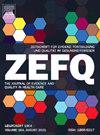[SARS-CoV-2大流行期间初级保健医生工作量调查:一项概念验证研究]。
IF 1.7
Q4 HEALTH POLICY & SERVICES
Zeitschrift fur Evidenz Fortbildung und Qualitaet im Gesundheitswesen
Pub Date : 2025-09-01
DOI:10.1016/j.zefq.2025.07.003
引用次数: 0
摘要
目的:从2020年至2022年SARS-CoV-2大流行的经验中得出的结论之一是需要初级保健/门诊护理数据,以便及时评估大流行的严重程度。由于德国大多数COVID-19患者主要由全科医生照顾,因此出现了一个问题,即是否可以通过定期评估全科医生的工作量和患者数量来绘制大流行的发病过程。方法:2021年1月至2021年6月,每两周进行12项基于互联网的重复性横断面调查。邀请已向德国全科医师/家庭医学协会(DEGAM)的所有成员和德国全科医师协会选定的联邦/区域成员组织发出。他们被问及个人工作量增加、COVID-19患者人数以及患者护理的其他情况。结果:平均每场调查有697名全科医生参与,共填写问卷8369份。参与者的组成在12个调查期间保持一致,82.9-87.2 %是实践所有者,32.0-40.7 %在团队实践中工作。随着时间的推移,报告工作量增加的医生比例在2021年2月达到最低24.2% %;从2021年3月开始,趋势逆转,在2021年5月达到峰值(88.1 %)。全科医生工作量的变化分阶段发展,与RKI官方报告的COVID-19发病率数据并行。报告的慢性病或社会问题患者护理赤字的增加没有显示出与报告的发病率趋势相当的时间动态。讨论:2021年1月至2021年6月期间对全科医生进行的一项重复性调查揭示了大流行条件下全科医生工作量的变化。在同一时期,SARS-CoV-2大流行的进展与观察到的工作量变化是平行发展的。因此,所使用的方法(在全科医生中进行基于互联网的重复性调查)可能是评估大流行进程的低门槛、节约资源的方法。尽管在大流行的不同浪潮期间工作量不断增加,但全科医生报告的对慢性病患者的护理不受任何大流行相关动态的影响。本文章由计算机程序翻译,如有差异,请以英文原文为准。
Erhebung der Arbeitsbelastung in der hausärztlichen Versorgung während der SARS-CoV-2-Pandemie – eine „Proof-of-Concept“-Studie
Objective
One of the conclusions from the experience with the SARS-CoV-2 pandemic of 2020 to 2022 was the requirement for data on primary care/ambulatory care to assess the severity of the pandemic in a timely manner. Since most patients with COVID-19 in Germany had been primarily cared for by general practitioners, the question arose whether the incidence course of a pandemic can be mapped by means of a regular evaluation of GP workload and number of patients.
Methods
From January 2021 to June 2021, 12 replicative, internet-based cross-sectional surveys were conducted fortnightly. Invitations were sent out to all members of the German Society of General Practice/Family Medicine (DEGAM) and selected federal/regional member organizations of the German Association of General Practitioners. They were asked about increases in personal workload, number of patients with COVID-19, and other conditions of patient care.
Results
On average, 697 general practitioners (GPs) participated in each survey and completed a total of 8,369 questionnaires. The composition of participants remained consistent across the 12 survey periods, with 82.9–87.2 % being practice owners and 32.0–40.7 % working in group practices. Over time, the proportion of physicians reporting an increased workload reached a minimum of 24.2 % in February 2021; from March 2021 onward, there was a trend reversal with a peak (88.1 %) in May 2021. The change in the GPs’ workload developed in phases that ran parallel to the official RKI reporting data on the COVID-19 incidence. The reported increase in the care deficit for patients with chronic diseases or social problems did not show a temporal dynamic comparable to the reported incidence trend.
Discussion
A replicative survey among GPs conducted between January 2021 and June 2021 revealed changes in the workload of general practitioners under pandemic conditions. The progression of the SARS-CoV-2 pandemic during the same period and the observed change in workload developed in parallel. The methodology used (an internet-based, replicative survey among GPs) could therefore be a low-threshold, resource-saving approach to assessing the course of a pandemic. Despite the increasing workload during the different waves of the pandemic, the care for chronically ill patients reported by the GPs was not subject to any pandemic-related dynamics.
求助全文
通过发布文献求助,成功后即可免费获取论文全文。
去求助
来源期刊

Zeitschrift fur Evidenz Fortbildung und Qualitaet im Gesundheitswesen
HEALTH POLICY & SERVICES-
CiteScore
1.90
自引率
18.20%
发文量
129
 求助内容:
求助内容: 应助结果提醒方式:
应助结果提醒方式:


